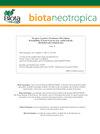弗朗西斯科河口浅水区鱼类区系组成及发生规律
IF 1.2
4区 环境科学与生态学
Q3 BIODIVERSITY CONSERVATION
引用次数: 0
摘要
摘要大坝的建设直接改变了河流的水文循环和生物地球化学循环,从而引起河流变量的变化。最显著的变化之一是流量调节,它减少了季节性事件和淡水施加的静水压力,增加了盐水楔块侵入系统。盐度变化会改变下游生态系统以及鱼类区系的分布和组成。在巴西,本文章由计算机程序翻译,如有差异,请以英文原文为准。
Patterns in composition and occurrence of the fish fauna in shallow areas of the São Francisco River mouth
Abstract The construction of dams causes changes in river variables, as a result of direct changes in their hydrological and biogeochemical cycles. One of the most notable changes is the flow regulation, which reduces seasonal events and the hydrostatic pressure exerted by freshwater, increasing the saltwater wedge intrusion into the system. Changing the salinity regime causes modifications in downstream ecosystems as well as in the distribution and composition of the fish fauna. In Brazil, the São Francisco River stands out, which has a system of cascading dams, built between the 70’s and 90’s. Because of these changes caused in the natural course of the river, this study aimed to analyze the patterns of composition and occurrence of the ichthyofauna at the mouth of the São Francisco River and relate them to the physical and chemical variables of the region. In order to evaluate the patterns of composition and occurrence of the fish fauna at the mouth of the São Francisco River, monthly trawls were conducted along the bank and physical and chemical variables were analyzed in the river channel over a period of one year. The relationship between abundance and species richness with environmental variables was verified using Generalized Linear Models. A total of 101,958 fish belonging to 87 taxa were caught, with emphasis on marine fish, both in number of individuals (99.92%) and in biomass (99.31%). A spatial gradient was detected, in which sites 1 and 2 were under marine influence, sites 3 and 4 represented the transition between the environments and site 5 was under the influence of brackish and freshwater. In general, the effect of the São Francisco River dams on the fish fauna was observed, with a predominance of fauna with more estuarine and less freshwater characteristics.
求助全文
通过发布文献求助,成功后即可免费获取论文全文。
去求助
来源期刊

Biota Neotropica
BIODIVERSITY CONSERVATION-
CiteScore
2.90
自引率
16.70%
发文量
0
审稿时长
4-8 weeks
期刊介绍:
BIOTA NEOTROPICA is an electronic, peer-reviewed journal edited by the Program BIOTA/FAPESP: The Virtual Institute of Biodiversity. This journal"s aim is to disseminate the results of original research work, associated or not to the program, concerned with characterization, conservation and sustainable use of biodiversity within the Neotropical region.
Manuscripts are considered on the understanding that their content has not appeared, or will not be submitted, elsewhere in substantially the same form, because once published their copyrights are transferred to BIOTA NEOTROPICA as established in the Copyright Transfer Agreement signed by the author(s).
 求助内容:
求助内容: 应助结果提醒方式:
应助结果提醒方式:


